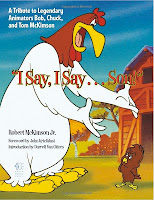While many gaps in animation history have been filled in the last 40 years, gaps remain. That's why any new book that fills in some blanks is to be celebrated. While Warner Bros. cartoons and certain of the directors have been covered relatively well, Bob McKimson has been present only intermittently in writings about the studio. Part of the reason is that he died just as animation history was moving into high gear and partially because he never attracted the critical or fan attention that directors like Chuck Jones did.
This book (with excerpts available at the link), written by McKimson's son, Robert Jr, also covers McKimson's brothers Tom and Chuck, both of whom also contributed to Warner Bros. cartoons in the areas of character design and animation respectively.
While the book covers their entire careers, it doesn't go into as much depth as I would have liked. Given that the author was a relative, I wish there had been more about the brothers as people. I didn't get a good picture of their personalities or their relationship.
As well, the book isn't specific enough about some of the work. Chuck McKimson animated for Bob for several years in the post-war period, but no scenes are identified as his work and there is no discussion about how his animation differed, if at all, from his brother's. While the author is right to point out that Bob McKimson was the only Warner Bros. director who continued to animate on his cartoons, with the exception of The Hole Idea (animated entirely by the director due to the studio shutting down temporarily), there are no animation scenes identified from his years as a director.
There's also no discussion of the evolution of the McKimson brothers' art over time. It's clear from the illustrations that their styles changed over the years, and not always for the better. By the 1950's, there's a tightness to some of Bob McKimson's drawings that compare unfavourably to his work during the 1940s. In the '50s, he had a tendency to draw arms and legs on characters like Bugs Bunny with parallel lines, causing the character to flatten out considerably. The liveliness and energy that he gave to Bugs in earlier years seems to have dissipated.
The best parts of the book are the illustrations, which cover a range of fields: animation, comics, colouring books and publicity artwork. The McKimson brothers had a definite influence on the look of Warner Bros. cartoons, especially in the years before the end of World War II. Bob and Tom were major contributors to the Bob Clampett unit and Bob McKimson was arguably the main artistic influence on the look of Bugs Bunny, first for Tex Avery and later for Clampett. As a director, Bob McKimson is probably best known for Foghorn Leghorn and the Tasmanian Devil, who appeared in his cartoons exclusively.
The McKimson brothers are certainly worthy of a book and this one is a start. As it is the best currently available, it is worth having, but there's a lot more to be said about the brothers and I hope that this isn't the last we'll read of them.
Subscribe to:
Post Comments (Atom)




No comments:
Post a Comment